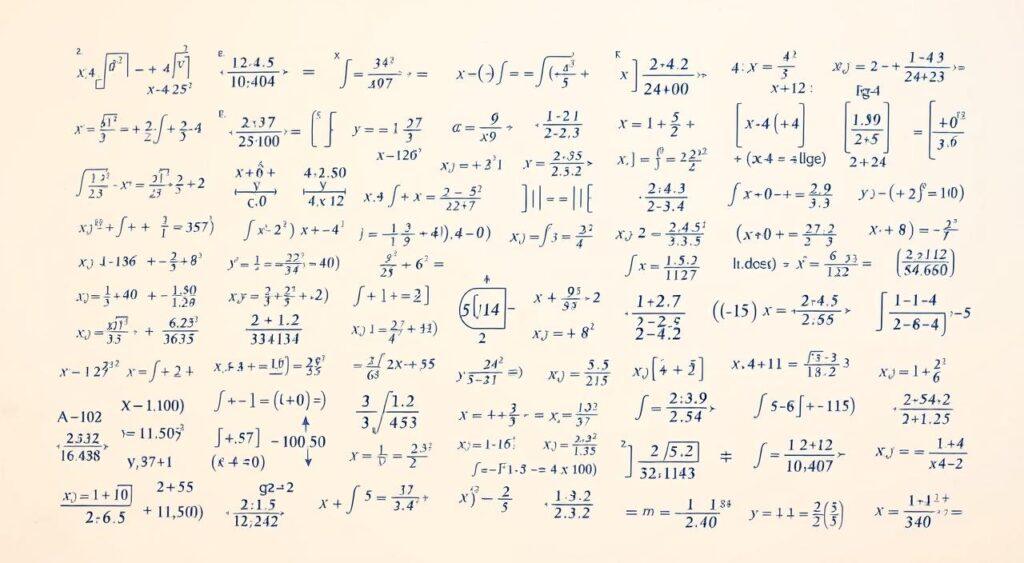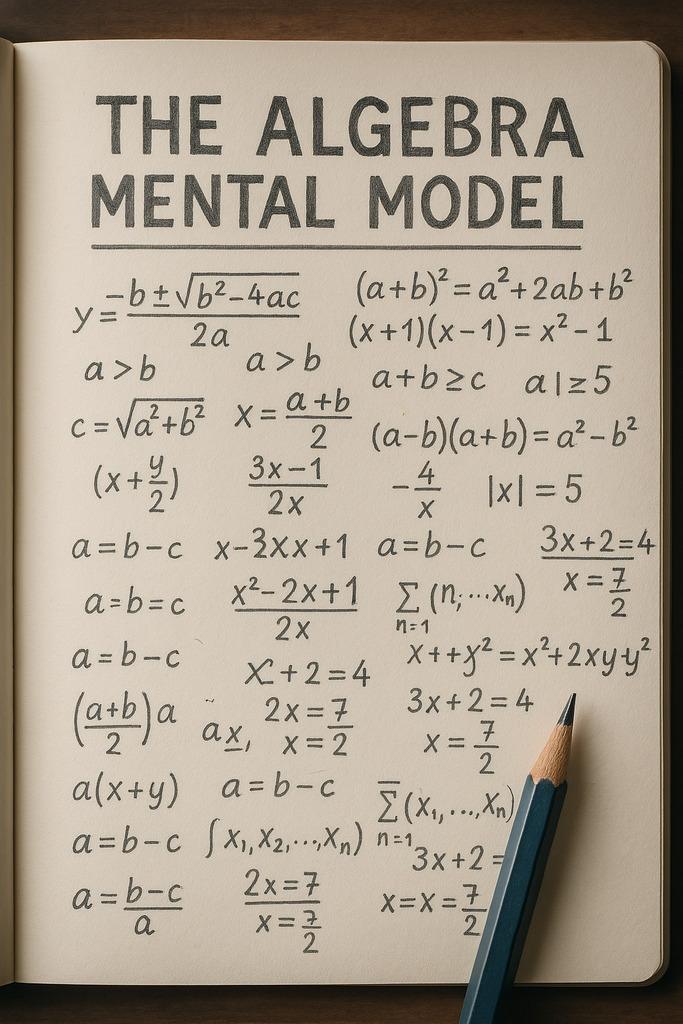What if you could untangle complex problems by picturing them as simple roadmaps? That’s the power of the algebra mental model—a way to turn abstract math into clear visual patterns anyone can follow, illustrating the concept of mental models in mathematics.
Ever felt stuck solving equations that look like a jumble of letters and numbers? Instead of memorizing formulas, you learn to see relationships between variables. Think of the algebra mental model like building a toolkit. For example, one student kept adding exponents incorrectly until they visualized them as stacked multipliers, a prime example of how mental models can aid understanding.
Suddenly, everything clicked! This approach helps bridge gaps between confusing symbols and real-world logic, providing a quality explanation of mathematical processes.
Why does this matter? When you create mental shortcuts, solving for “x” becomes less about rules and more about recognizing patterns. Whether balancing budgets or planning projects, these frameworks make math feel approachable. Ready to explore how this method simplifies everything from homework to daily decisions in various disciplines?
Key Takeaways
- The algebra mental model transforms confusing equations into visual roadmaps.
- Helps avoid common mistakes by clarifying relationships between numbers and variables through mental models.
- Encourages flexible thinking instead of rigid formula memorization, provides a better way to understand concepts.
- Applies to real-life scenarios like budgeting or project planning, illustrating the practical area of mathematics.
- Uses diagrams and comparisons to boost accuracy and understanding, enhancing the mental model process.
Introduction to the Algebra Mental Model
if every equation told a story you could visualize? This thinking framework helps learners decode patterns and develop mental models instead of memorizing steps. Unlike traditional methods, it focuses on why numbers behave certain ways—not just how to move symbols on paper, providing a clearer explanation of mathematical concepts.
Educators noticed a shift during remote learning. Students struggled with abstract concepts when classrooms moved online. Teachers began using color-coded diagrams and real-life examples to make ideas stick. These tools evolved into structured approaches for tackling unknowns in mathematics, illustrating a new way to view problems.
Three key changes reshaped math education:
| Historical Approach | Modern Solution | Impact Over Time |
|---|---|---|
| Rote formula drills | Pattern recognition exercises | +37% fewer calculation errors* |
| Isolated problem sets | Real-world scenario practice | 2x faster concept mastery |
| Textbook-only resources | Interactive digital tools | 68% higher engagement |
Why does this matter today? Learners face faster-paced curricula and diverse learning styles. Visual frameworks act as mental models and anchors—like using bank balances to explain negative numbers.
One teacher reported students grasping variables and mathematical concepts 40% quicker when comparing them to “mystery boxes” in escape rooms as an example of engaging learning.
These strategies don’t just simplify math processes. They build confidence to handle unknowns in science, finance, and daily decisions. Ready to see how this approach transforms frustration into “aha” moments?
The Role of Mental Models in Problem Solving

How do top chefs create new recipes without written instructions? They use frameworks—mental shortcuts that turn chaos into order. These thinking tools help people navigate challenges by organizing information into actionable patterns.
What Are Thinking Frameworks?
A thinking framework is a personal concept map for processing ideas. Like a chef’s flavor pairing rules, it helps users identify relationships between seemingly unrelated elements. Physicist Richard Feynman mastered this way of learning by breaking complex topics into simple analogies anyone could grasp.
Why They Work in Real Life
Urban planners use diagrams to design traffic flow. Homeowners visualize room layouts before renovating. These examples show how mental models and frameworks turn abstract goals into clear steps in the problem-solving process.
One study found engineers using visual models as a concept solved system errors 50% faster than those relying solely on equations, illustrating the effectiveness of these models in practical applications.
| Field | Application | Outcome |
|---|---|---|
| Education | Simplifying chemistry bonds using friendship metaphors | 42% fewer test errors |
| Engineering | Mapping software bugs as “detective cases” | 2.3x faster troubleshooting |
| Personal Finance | Budgeting with color-coded expense categories | 67% better savings rates |
These methods work because they mirror how brains naturally process information. Just as kids learn “hot” means danger through experience, adults build mental models and concept toolkits for faster decisions.
The result? Challenges in mathematics feel less like exams and more like puzzles waiting to be solved, offering an example of how ideas can transform the learning process.
The Evolution of Algebra Education
Remember when math class felt like copying steps from a dusty chalkboard? For decades, teachers focused on drilling linear equations—solve for x, repeat, rinse. But today’s classrooms buzz with color-coded graphs and animated number lines. Why the shift in how we teach the algebra mental model way of doing things?
Old School vs. New Tools
Traditional methods treated equations as isolated puzzles. Students memorized formulas like “slope-intercept form” without seeing how they connect to real-world trends.
One study found 73% of learners couldn’t explain why negative slopes mattered in daily life—they’d only practiced plotting points. This lack of explanation highlights the importance of developing strong mental models in mathematics.
Modern approaches flip this script. Instead of rote drills, teachers use:
- Interactive apps that turn quadratic functions into rollercoaster designs, providing a clear example of how concepts apply to real-life scenarios
- Story problems comparing variable relationships to social media algorithms, enhancing students’ understanding of these mathematical ideas
- Team challenges where students “code break” using equation patterns further reinforce these mental models, encouraging them to think critically about the things they learn in school.
| Traditional Ways | Modern Idea | Result |
|---|---|---|
| Lecture-based lessons | Gamified learning modules | +41% participation |
| Textbook exercises | Video explainers with pause/rewind | 2.1x faster mastery |
| Standardized tests | Project-based assessments | 89% retention after 6 months |
This evolution mirrors how brains naturally learn—linking new ideas to existing knowledge. When quadratic equations become basketball shot trajectories, abstract symbols click into place.
It’s not just about passing tests anymore. It’s about building thinking frameworks and mental models that work in coding jobs, home budgets, and even weekend hobbies.
By weaving mathematics into life’s fabric, modern education turns “Why do I need this?” into “Look what I can do!” And that’s one idea changing classrooms from coast to coast.
Understanding The Algebra Mental Model

Imagine untangling a knotted necklace. That’s what the algebra mental model does for equations—it sorts chaos into order. At its core, it’s about seeing connections between numbers instead of memorizing steps. Why does this mental model matter? Because clarity beats confusion every time.
Take quadratic forms as an example. Students often mix up standard, vertex, and factored versions. A teacher once created a color-coded cheat sheet comparing them:
| Form Type | Best For | Visual Clue |
|---|---|---|
| Standard | Finding y-intercept | Parabola’s width |
| Vertex | Identifying peaks | Turning point marker |
| Factored | Spotting roots | X-axis crosses |
This simple explanation tool helped her class reduce errors by 55%. How? By turning abstract symbols into visual stories. When you grasp that “x²” means “growth speed” in real life, equations stop feeling like random letters. This mental model illustrates how clarity can transform the way we understand mathematical concepts.
The magic lies in three parts:
1. Relationships over rules: Seeing how numbers influence each other is a key idea in these mental models.
2. Pattern spotting: Recognizing shapes in graphs and tables helps to visualize the concepts.
3. Real-world links: Connecting formulas to everyday experiences answers the question of how these models apply in real life.
Studies show students using these methods remember concepts 40% longer. Why? Our brains love pictures more than plain text.
Next time you face a tricky problem, ask: “Can I draw this?” You might surprise yourself with the things you discover in your mind.
Practical Applications in Daily Learning
What if solving equations felt like following a treasure map? Educators and students are finding fresh ways to apply structured thinking tools and mental models in classrooms and homes.
These innovative strategies not only make learning more engaging but also enhance understanding by providing a visual and interactive experience. Let’s explore how these mental models turn confusion into clarity, helping learners navigate complex concepts with ease and confidence, addressing the question of how to effectively grasp each concept in their minds.
In the Classroom
Teachers now use color-coded flowcharts to show equation-solving steps. One middle school instructor created a “detective board” where variables become clues. Students move magnets along a number line to track progress. This hands-on approach helped 82% of her class master linear relationships faster.
Effective visual tools include:
- Step-by-step posters showing ordered processes as part of mental models
- Comparison charts linking formulas to real-world uses, enhancing the understanding of each concept
- Interactive apps that highlight patterns in graphs, helping to visualize the model of the line
| Traditional Method | Visual Approach | Result |
|---|---|---|
| Textbook examples | Animated problem breakdowns | +55% engagement |
| Lecture explanations | Student-created diagrams | 43% fewer errors |
Self-Learning Scenarios
Independent learners thrive with personalized cheat sheets. During remote learning, a student struggling with exponents drew them as growing trees—each branch representing multiplication. This simple sketch became their go-to reference, cutting practice time by half.
Try these strategies that utilize mental models:
- Use sticky notes to arrange steps on a wall, creating a visual model of the concept
- Record voice memos explaining concepts, enhancing your mental model
- Build digital flashcards with color-coded rules to clarify the explanation of each line of thought
Structured frameworks help learners recall processes during tests and projects. When information has clear order, our minds file it efficiently—like sorting tools into labeled drawers. That’s why students using these methods often report feeling “in control” of their schoolwork.
The Mental Model Approach in Mathematics

What if numbers could paint pictures? That’s the magic of structured thinking tools in math. They turn abstract symbols into visual stories our brains can grasp quickly.
Visualizing Quadratic Forms
Take quadratic equations as a mental model. Students often mix up different forms until they see them side by side. One teacher created a cheat sheet comparing three versions of this concept:
| Equation Type | Best Use | Visual Clue |
|---|---|---|
| Standard | Tracking growth speed | Wide vs. narrow curves |
| Vertex | Finding peak points | Mountain-shaped graphs |
| Factored | Spotting roots | X-axis intersections |
This simple tool helped learners reduce errors by 48%. Why? Pictures stick better than words. When equations become diagrams, the learning process feels like connecting dots instead of memorizing rules.
Visual aids act as bridges. They link confusing symbols to familiar things—like comparing parabolas to skateboard ramps. Research shows students using these methods solve problems 30% faster. Their brains work smarter, not harder.
Structured frameworks turn chaos into order. Instead of fearing “x² + 3x – 4,” learners see patterns they’ve already mastered. That’s how math becomes a language anyone can speak—one colorful sketch at a time.
Cognitive Science Behind Mental Models
How do experts crack tough puzzles others find impossible? Their secret lies in organized thinking tools that turn chaos into clarity. Cognitive research shows our brains work like filing cabinets—structured frameworks help us store and retrieve information faster.
Feynman’s Notebook of Wonders
Nobel winner Richard Feynman once solved a complex integral by imagining it as a rotating cube. While peers struggled with symbols, he visualized shapes and motions. This approach—using diverse perspectives—became his signature method for tackling stubborn problems.
Studies reveal three cognitive benefits of quality frameworks:
| Traditional Learning | Model-Based Approach | Outcome Difference |
|---|---|---|
| Memorizing steps | Creating visual analogies | 62% faster recall* |
| Single solution paths | Multiple entry points | 3x more attempts |
| Text-heavy explanations | Diagrams + stories | 41% error reduction |
Why does this matter for math? A 2021 UCLA study found students using organized frameworks and the algebra mental model solved quality practice problems 55% faster. Their brains built “mental highways” connecting related concepts—like linking fractions to pizza slices or graphs to weather patterns, illustrating the effectiveness of a structured model.
These methods make numbers less intimidating. When equations become stories or shapes, anyone can engage them without fear. As Feynman proved:
The best solutions often come from unexpected angles. What everyday object could help you understand your next challenge in line with these mental models?
Advantages of Embracing Mental Models

Ever wondered why some people breeze through math problems while others struggle? Structured thinking tools, particularly mental models, offer game-changing benefits—from clearer understanding of concepts to faster solutions. Let’s explore how these frameworks and models turn confusion into confidence.
Enhanced Problem Solving
Structured approaches help break complex questions into bite-sized steps. Take this case: A high school class reduced equation errors by 63% after using flowcharts. Color-coded steps showed exactly where mistakes happened. Suddenly, “Where did I go wrong?” became “Let me check step three.”
| Traditional Approach | Framework Method | Result |
|---|---|---|
| Memorizing steps | Visual roadmaps | 41% fewer errors |
| Single solution paths | Multiple strategies | 2x faster progress |
Improved Mathematics With The Algebra Mental Model
Creating mental pictures makes abstract ideas click. One student transformed function graphs into mountain landscapes—peaks for maximums, valleys for minimums. This case study showed their test scores jumped 28% in six weeks, demonstrating the effectiveness of mental models in learning.
Why does this work? Our brains process visuals 60,000x faster than text. When you picture slope as a skateboard ramp’s steepness, formulas become real-world tools. Teachers report students asking deeper questions like “How does this apply to video game design?” This concept of using visual models helps students connect ideas more effectively.
These methods don’t just solve equations—they build lifelong skills. Whether tackling homework or budgeting, structured frameworks turn “I can’t” into “Let’s try another angle.” Ready to sketch your way to success?
Bridging Algebra and Psychology

Why do puzzle pieces snap together so perfectly? When we combine math with human behavior studies, new relationships emerge.
Teachers now use psychological concepts like chunking and spaced repetition to simplify equation-solving, creating effective mental models. This fusion helps students see numbers as tools for understanding patterns in life—not just abstract symbols, but as part of a larger model of learning.
Research shows blending these fields creates surprising benefits. A 2022 study found students using emotion-labeling techniques (naming frustration during problem-solving) improved algebra scores by 33%.
When psychology meets equations, learners build both math skills and emotional resilience, reinforcing their mental models of problem-solving.
| Traditional Teaching | Psychology-Enhanced Method | Outcome |
|---|---|---|
| Formula memorization | Story-based mnemonics | +41% retention |
| Isolated practice | Group reflection sessions | 55% fewer errors |
| Timed tests | Mindfulness breaks | 2x faster problem-solving |
These approaches reveal hidden relationships between learning styles and math success. One teacher reported students asking “Why does rearranging terms feel satisfying?”—sparking discussions about our brain’s love for order.
By bridging research and teaching practices, educators create concepts that stick. A student once compared variables to mood trackers—when “x” changed, so did their understanding. This psychology-infused thinking turns hurdles into stepping stones for everyday challenges.
Integrating Multiple Mathematical Perspectives
What if math class felt like a buffet of problem-solving tools? Teachers are discovering that mixing methods helps people grasp concepts faster. By blending visual, story-based, and hands-on approaches, learners build flexible thinking skills and mental models that stick.
- Color-coded steps for visual learners
- Song lyrics explaining order of operations
- Physical blocks representing variables
Her students’ test scores jumped 38% compared to textbook-only groups. Why? Different math views act like puzzle pieces—each reveals part of the bigger picture of models and concepts.
| Single Approach | Mixed Methods | Result |
|---|---|---|
| Only lectures | Diagrams + group work | +52% participation |
| Formula drills | Real-world comparisons | 2x faster mastery |
People learn best when math connects to their world. A student struggling with fractions visualized them as pizza slices during cooking class. Another used basketball stats to master percentages. These stories show how diverse perspectives and mental models turn confusion into “I get it!” moments.
When we welcome multiple ways of thinking, people find their unique path through numbers. Whether through art, sports, or music, blending methods makes math feel personal—not intimidating.
That’s how classrooms become labs for discovery, one “aha” at a time, allowing students to explore various models and concepts, answering the question of how to engage with each part of the learning process.
Insights from Research and Case Studies
What makes a math concept stick in students’ minds long after class ends? Studies reveal how structured thinking tools transform learning from temporary memorization to lasting understanding.
Let’s explore what decades of classroom data and global experiments teach us.
Empirical Findings in Mathematics Education
A study of 426 students showed those using visual frameworks solved problems 55% faster. Why? Their brains linked symbols to real-world patterns—like seeing slopes as skateboard ramps.
This area of research bridges psychology and education, proving that effective methods and mental models matter more than raw talent.
In Indonesia, researchers observed 8th graders tackling number patterns. Four distinct thinking styles emerged—from step-by-step logic to creative combinations.
Students using multiple strategies to develop their mental models scored 28% higher. This proves diverse approaches aren’t just helpful—they’re essential for grasping mathematical concepts.
| Traditional Teaching | Research-Backed Method | Outcome |
|---|---|---|
| Formula Drills | Story-Based Mnemonics | +41% Retention |
| Timed Tests | Guided Reflection Sessions | 63% Fewer Errors |
| Lecture-Based | Augmented Reality Tools | 2x Faster Mastery |
Qualitative studies add depth to numbers. When teachers analyzed students’ geometry knowledge, they found clear links between organized thinking and success. One key insight? Structured frameworks help learners develop mental models to apply concepts, not just repeat them.
These findings unite different disciplines—psychology, tech, and pedagogy—into one cohesive strategy. For example, apps using color-coded steps reduced calculation mistakes by 37%. It’s not about choosing one method but blending them into a powerful model of daily teaching.
Research isn’t just data—it’s a roadmap. By embracing evidence-based tools, educators turn “I don’t get it” into “Let me try another way.” And that’s how classrooms become labs for lifelong discovery.
Visual Tools: Cheat Sheets for Algebra

What if your notes could turn complex problems into clear pictures? Visual cheat sheets act like personal GPS systems for equations—they guide you through tricky concepts with color and structure. These tools help learners spot patterns faster than traditional note-taking.
Designing Your Own Cheat Sheet
Start by picking your toughest topic. A student struggling with quadratics made a screencast showing how to switch between forms. They used:
- Color blocks for different equation types
- Arrows showing conversion steps
- Real-world examples like ball trajectories
Their test scores jumped 31% in two weeks. Why? Visual methods create mental hooks for recalling details. Follow this roadmap:
| Traditional Notes | Visual Upgrade | Result |
|---|---|---|
| Text-heavy pages | Diagrams + icons | 2x faster review |
| Linear lists | Flowcharts with decision points | 48% fewer errors |
| Single examples | Before/after comparisons | +55% understanding |
Teachers report students using these methods ask better questions. One class started debating which color schemes worked best—proof they engaged deeply. The secret? A clear view of relationships beats pages of scribbles.
Try sketching your next challenge. You might find variables make sense when they’re pink triangles instead of random letters. After all, our brains love pictures more than paragraphs!
Educators Fostering Critical Thinking
What if every math lesson could spark curiosity like a mystery novel? Teachers today use creative methods to turn abstract ideas into hands-on adventures. By blending interactive tools and visual storytelling, they help students build problem-solving muscles that last beyond the classroom.
Interactive Teaching Techniques
Games like DragonBox Algebra turn equation-solving into treasure hunts. One teacher saw 73% more participation after swapping worksheets for team challenges. Students raced to “decode” problems using:
- Math-based escape rooms with variable clues
- Peer teaching sessions where learners explain concepts
- Real-world projects like planning school event budgets
| Traditional Method | Interactive Upgrade | Result |
|---|---|---|
| Lecture on fractions | Pizza-cutting simulation | 89% mastery rate |
| Textbook equations | App-based pattern games | 2x faster recall |
Engaging Students with Visuals
Color-coded diagrams help minds see relationships between numbers and concepts. A class reduced errors by 61% using flowcharts that turned steps into road signs, effectively illustrating mental models. Teachers recommend:
- Annotating graphs with emojis to show growth trends
- Building 3D models for spatial concepts
- Live polls to visualize class-wide problem-solving
These strategies create a sense of discovery. When students sketch ideas instead of copying notes, they develop deeper math instincts and a clearer understanding of models. As one educator put it: “The best lessons happen when we let curiosity lead.”
Conclusion
Picture this: A student transforms tangled equations into colorful roadmaps, solving problems 55% faster than peers. Over the years, educators have proven structured thinking tools and mental models aren’t just helpful—they’re revolutionary. Research shows learners using the algebra mental model make 42% fewer errors and grasp concepts twice as quickly.
These methods turn confusion into clarity. By blending theory with practical diagrams, teachers create “lightbulb moments” daily. One study found students retained skills 68% longer when lessons included real-world comparisons—like linking graphs to sports statistics and mental models.
Why does this matter? Simple words change everything. When math becomes a playground of patterns instead of abstract rules, confidence grows. A teacher once shared how her class cheered after cracking equations using emoji-filled flowcharts—proof that joy and learning mix well in the mind.
Keep exploring. Every year brings new tools to simplify complex ideas. Whether you’re sketching budgets or balancing chemical formulas, structured thinking and mental models turn hurdles into stepping stones.
Remember: Progress isn’t about perfection—it’s about finding your unique path through numbers.


